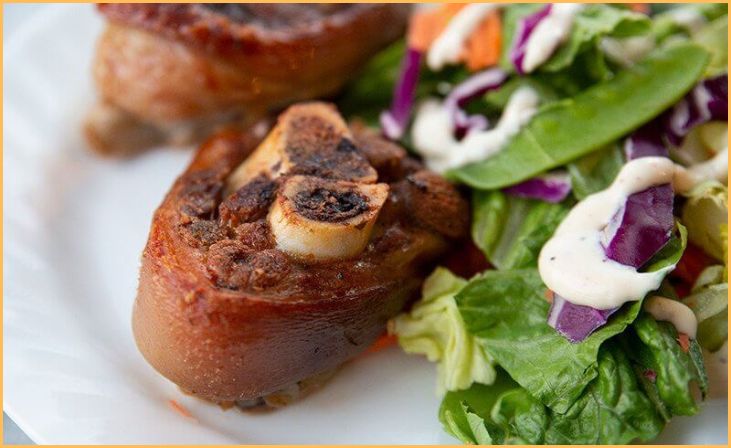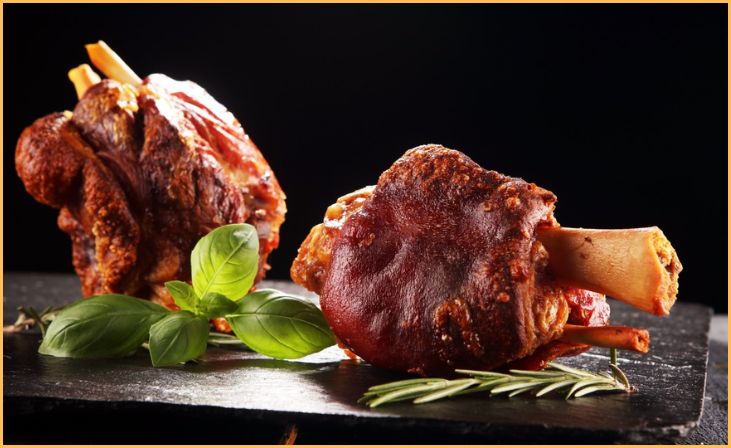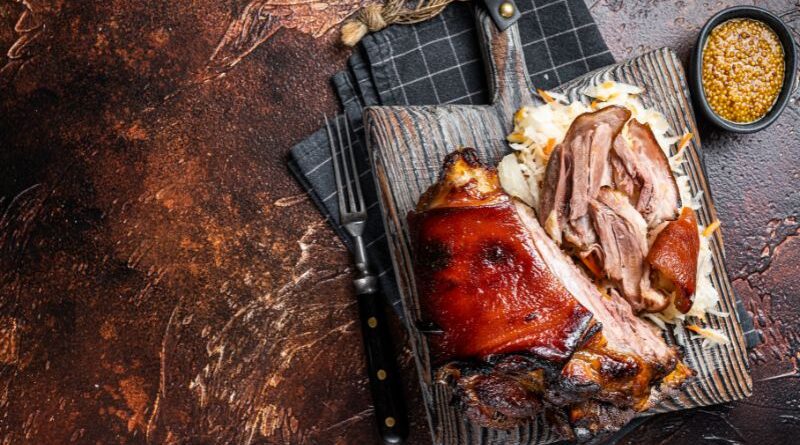Ham Shank vs Ham Hock
Ham hocks are the joint between a pig’s foot and leg. Therefore they’re primarily skin, tendons, and ligaments with little meat. On the other hand, Shanks originate from right below the pig’s shoulder or hip and are meatier than hocks. The article contains a brief overview of ham shank vs. ham hock with each detail. As winters are approaching, We all love to taste some hot, slowly simmered soup that warms us up. You can, however, add some punch to the soup’s flavor by adding ham hocks or ham shanks.
I know it is unassuming for a few of you, and yes, it also takes a long time to cook Ham to emerge its flavor and goodness. However, I promise it will be worth your time. So, firstly, let’s start with a discussion on what is precisely Ham shank and Ham hock and the differences between both. Let’s get started ham shank vs ham hock!
What is Ham Hock?

Ham hocks, alternatively known as pork knuckles, are derived from the lower portion of the pork leg, predominantly comprising bone, fat, connective tissue, and a moderate amount of meat. Renowned for their robust and savory essence, ham hocks necessitate a prolonged cooking duration to tenderize and impart their distinctive flavors, making them most suitable for dishes that undergo slow, leisurely cooking processes.
Typically cured with salt and imbued with a smoky essence through smoking, ham hocks boast a rich, salty flavor profile akin to that of bacon. This curing and smoking process enhances their taste, rendering them an exceptional addition to recipes seeking an infusion of depth and complexity.
Their composition, comprising a medley of bone, fat, and connective tissue, necessitates patient cooking methods to coax out their full potential. Slow-cooked preparations allow the collagen-rich tissues to break down gradually, rendering the meat succulent, tender, and infused with the essence of the ham hock’s distinct flavors.
Read Also: What Do Scallops Look Like: Flavor, Texture and Storage
What are the Uses of Ham Hock?
Despite its limited amount of meat, ham hocks are something of a delicacy, and they are often drizzled with sweet glazes to contrast with the smoky flavor of the meat. Simmer it until the meat comes off the bone, shred it, and eat it hot or cold.
You can infuse soups or vegetable dishes with extra flavor using a ham hock. A large amount of cooking is required to make the meaty parts palatable. They are often prepared slowly with vegetables and soups so that the collagen and fat can dissolve and impart a savory and smoky taste.
What is Ham Shank?

A Ham shank is the meat cut that is taken from the bottom half of the leg. There is not much fat at the end of the ham shank compared to the end of the butt. But the pro is that it contains only one bone, making it easy to carve. The flavor of the ham shank is slightly sweeter. If the cut is labeled ” shank half,” it has not excluded the center ham slice. If the center slice has been cut, the cut will be labeled ” shank portion.”
What are the Uses of Ham Shank?
The ham shank, known for its affordability, presents an excellent option for a satisfying family meal that’s both convenient and straightforward to prepare. Its simplicity makes it an ideal centerpiece for a quick and effortless dinner. A simple yet effective method involves baking the ham shank, allowing for easy slicing and pairing it with your preferred vegetable side dish. Its versatility extends beyond the initial meal, as any leftovers can be repurposed to create delicious sandwiches or utilized in various experimental culinary endeavors.
The baking process renders the ham shank tender and flavorful, requiring minimal effort for a delectable meal. Once cooked, slicing it into portions and serving it alongside your chosen vegetable side dish offers a satisfying and wholesome dining experience that’s sure to please the whole family.
Differences Between Ham Shank and Ham Hock

These skin-on, bone-in pig chops have a lot in common, including abundant oozy collagen, which gives your meat body and a smooth, silky texture. Furthermore, hocks and shanks are typically sold smoked, using them interchangeably to infuse a meal with a subtle, bacony taste. It’s worth noting, though, that ham hocks and shanks are not created equal — they come from two separate pig areas, and one is meatier than the other, making it more flexible.
Ham hocks are the joint between a pig’s foot and leg. Therefore they’re primarily skin, tendons, and ligaments with little meat. On the other hand, Shanks originate from right below the pig’s shoulder or hip and are meatier than hocks.
How do you feel about my article on ham shank vs. ham hock? Let me know in the comments.
Conclusion
The contrast between a ham shank and a ham hock unveils two specific sections of the pork leg, each possessing its own distinctive culinary traits. Despite originating from the same region of the hog, these portions differ in their location and attributes, rendering them ideal for various cooking methods and recipe applications, enriching the spectrum of culinary possibilities.
Derived from the pork leg, the ham shank represents the lower portion closer to the ankle, characterized by a meatier section surrounding a substantial bone. It typically contains less fat compared to the hock. Conversely, the ham hock originates from the upper part of the hind leg near the hip joint. Known for its higher fat content, the hock boasts a gelatinous texture and flavorful meat encircling the bone.
These differences in positioning and composition dictate their suitability for distinct culinary purposes. The meatiness of the ham shank makes it well-suited for roasting or braising, offering a leaner yet substantial cut. In contrast, the richness and higher fat content of the ham hock, coupled with its collagen, make it an exceptional choice for adding depth of flavor and richness to soups, stews, and slow-cooked dishes.
FAQs
A ham shank refers to the lower portion of the pork leg, closer to the ankle, featuring a meaty section with a substantial bone and typically less fat compared to the hock.
A ham hock is the upper portion of the pig’s hind leg, nearer to the hip joint, known for its generous fat content, gelatinous texture, and flavorful meat surrounding the bone.
Ham shanks are suitable for roasting or braising due to their meatiness and moderate fat content. Ham hocks, with their higher fat content and collagen, excel in adding depth of flavor and richness to soups, stews, and slow-cooked dishes.
Ham hocks, owing to their higher fat and collagen content, infuse dishes with richer flavors and impart a luscious texture during slow cooking, making them a preferred choice for flavor enhancement.
Ham shanks tend to have a leaner and firmer texture due to their lower fat content, while ham hocks boast a gelatinous, tender texture when cooked, owing to their fat and collagen content.







